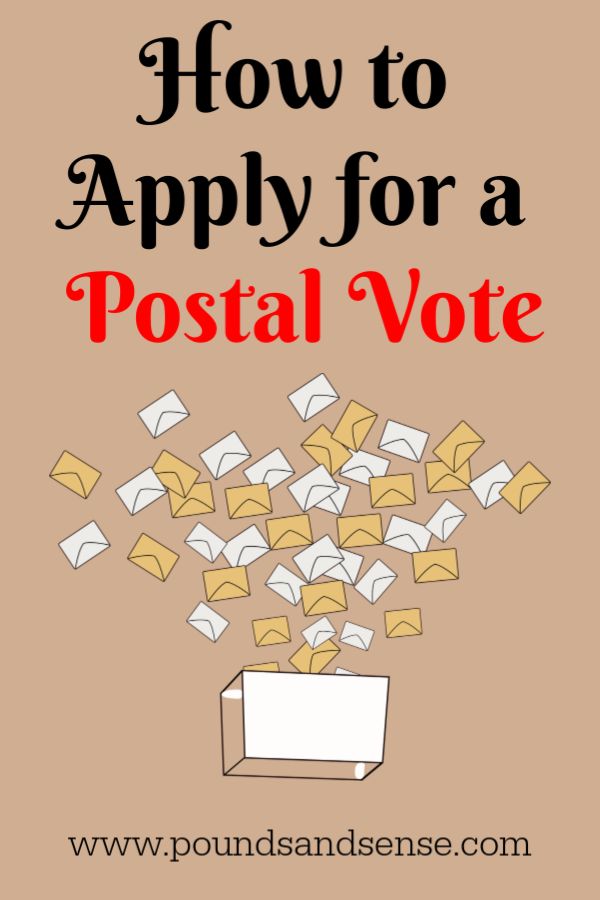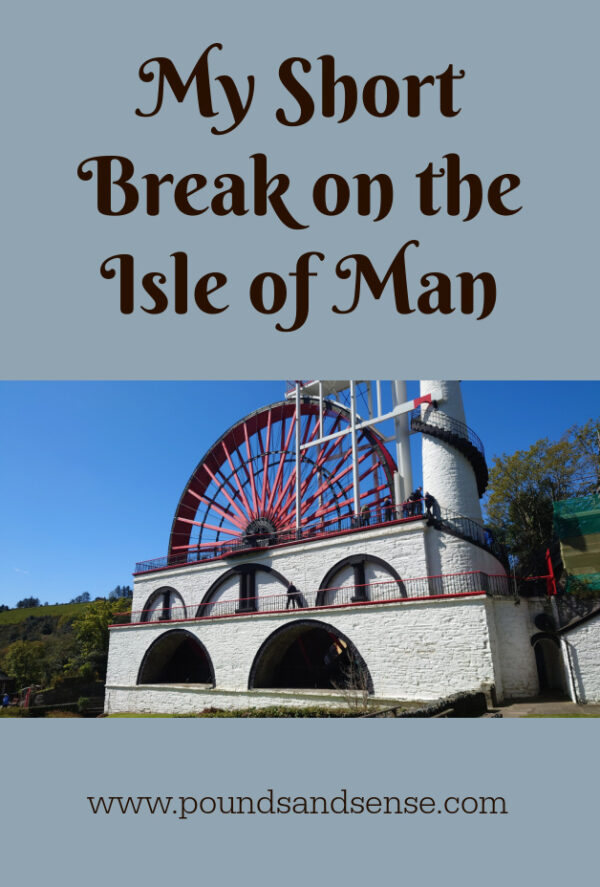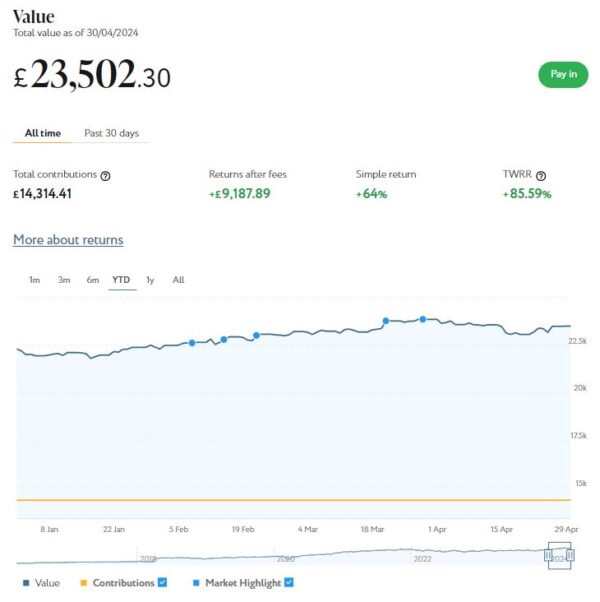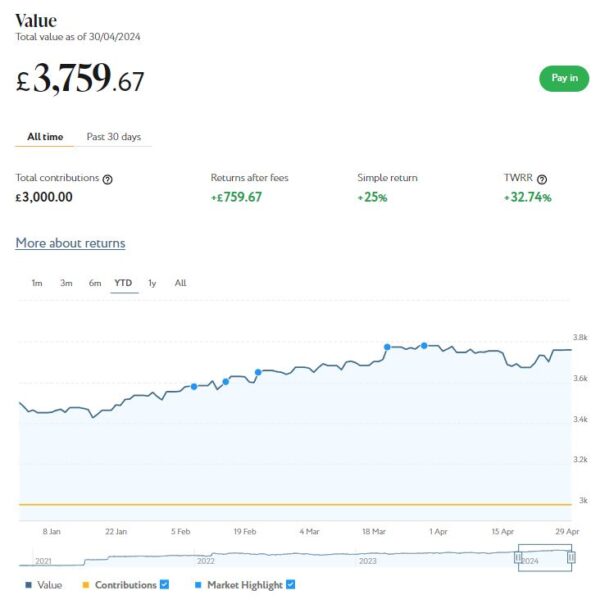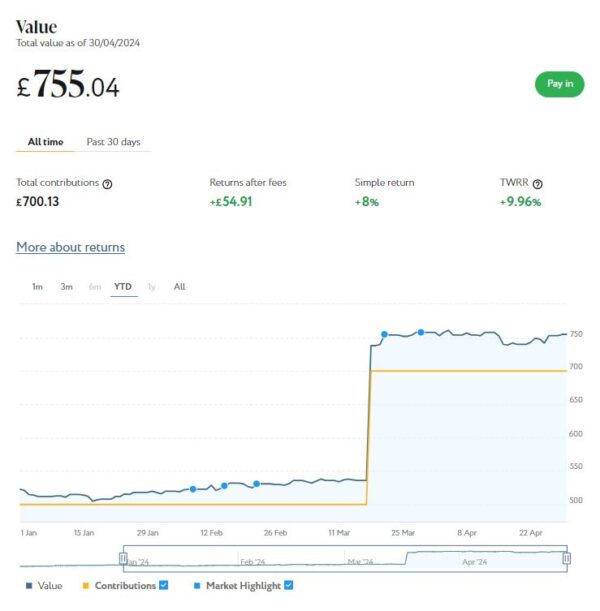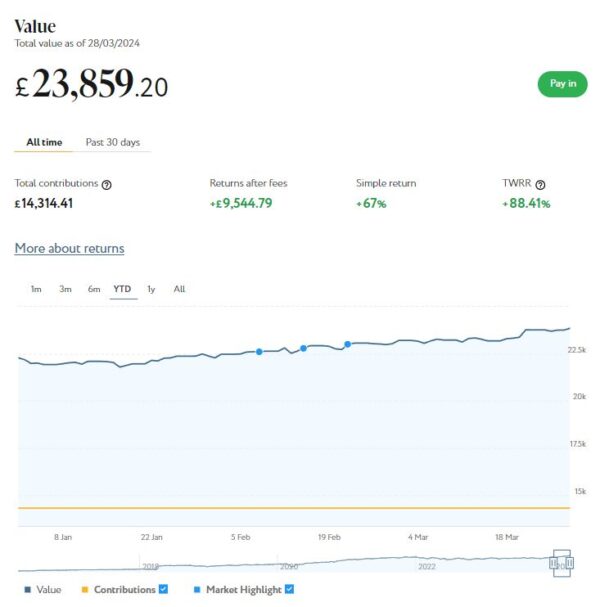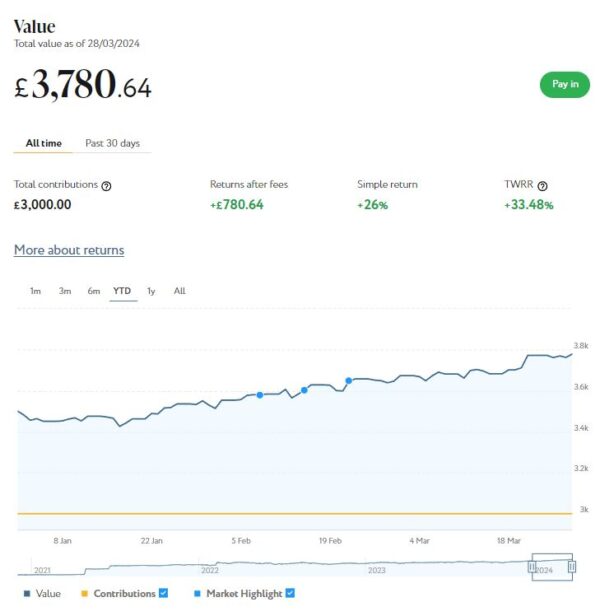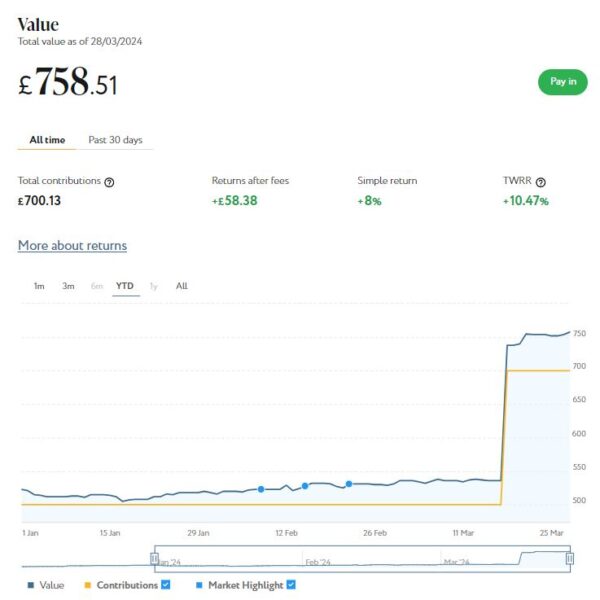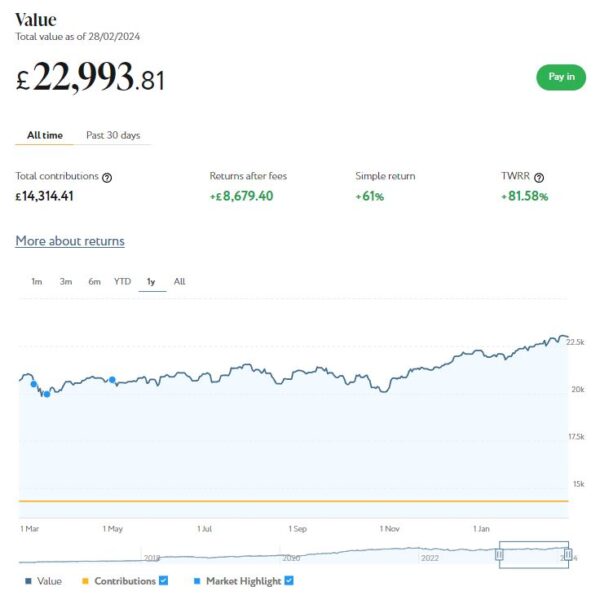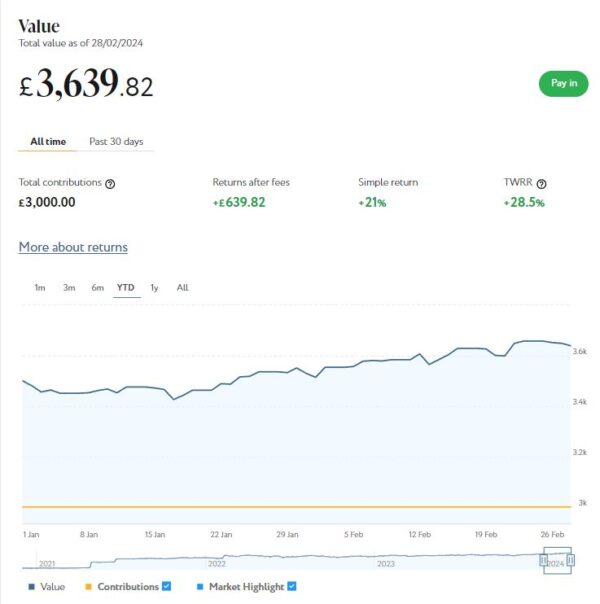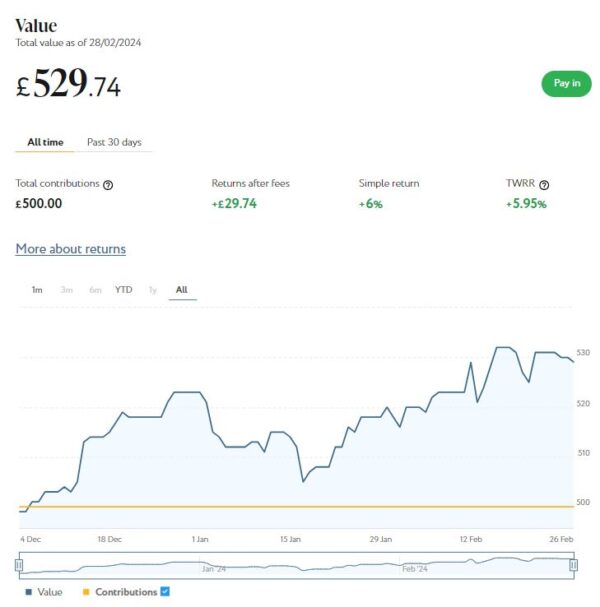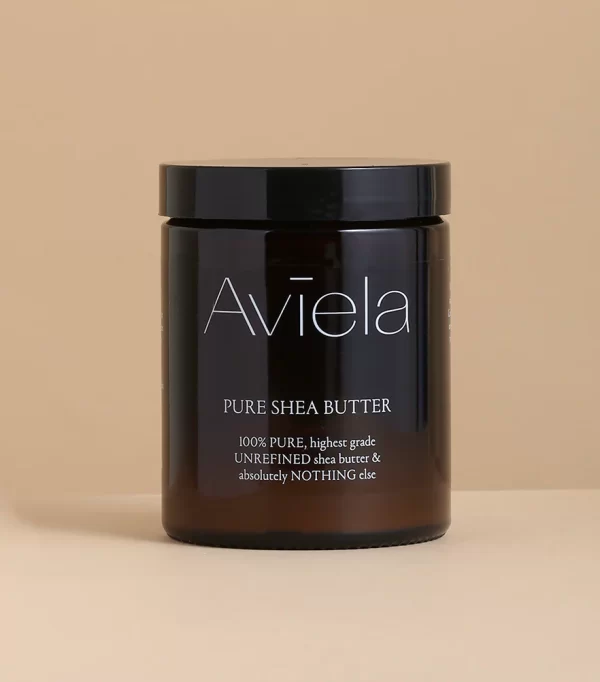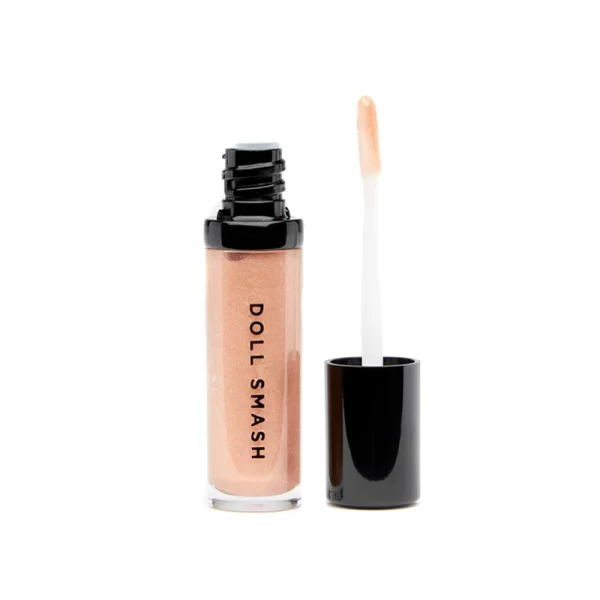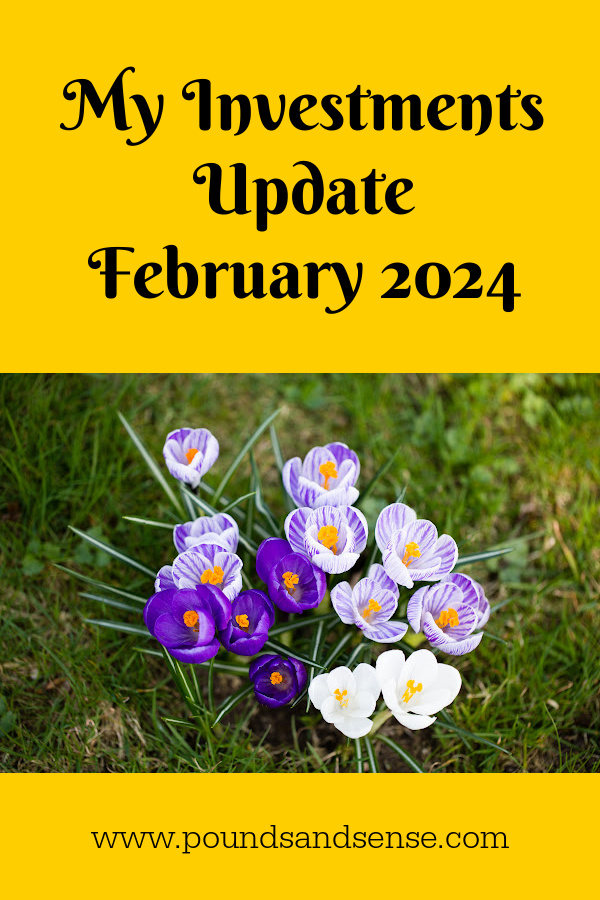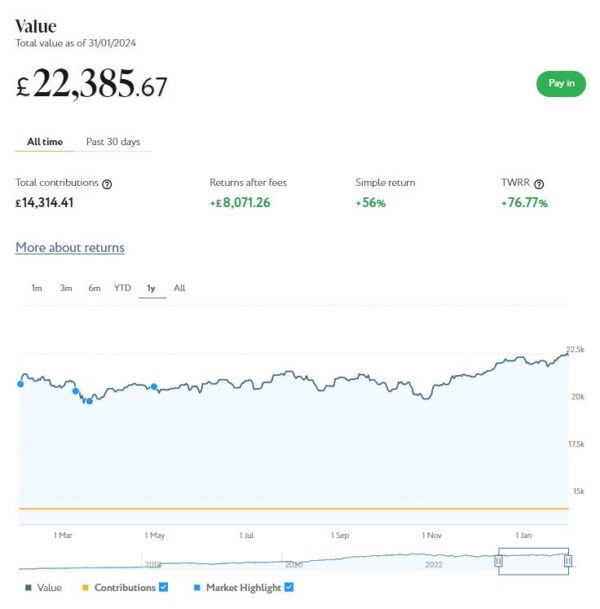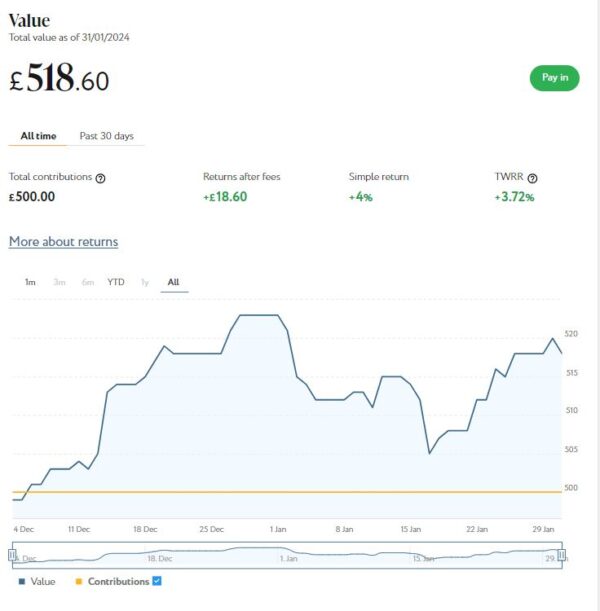My Investments Update – June 2024
Here is my latest monthly update about my investments. You can read my May 2024 Investments Update here if you like
I’ll begin as usual with my Nutmeg Stocks and Shares ISA. This is the largest investment I hold other than my Bestinvest SIPP (personal pension).
As the screenshot below for the year to date shows, my main Nutmeg portfolio is currently valued at £23,744. Last month it stood at £23,502, so that is an increase of £242.
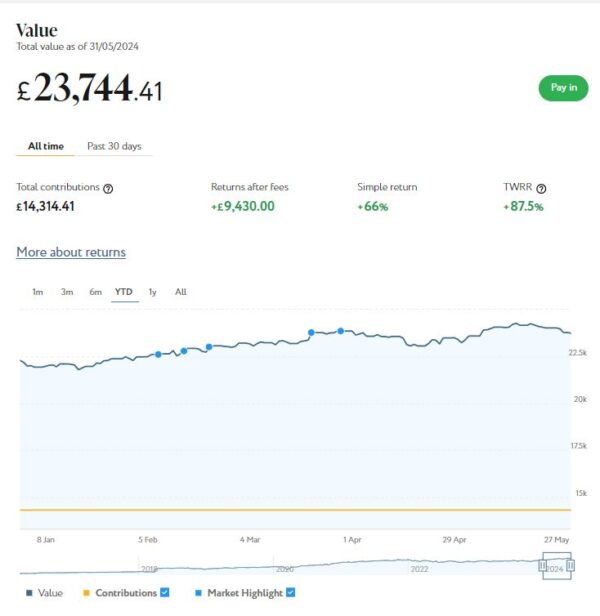
Apart from my main portfolio, I also have a second, smaller pot using Nutmeg’s Smart Alpha option. This is now worth £3,808 (rounded up) compared with £3,760 a month ago, a rise of £48. Here is a screen capture showing performance over the year to date.
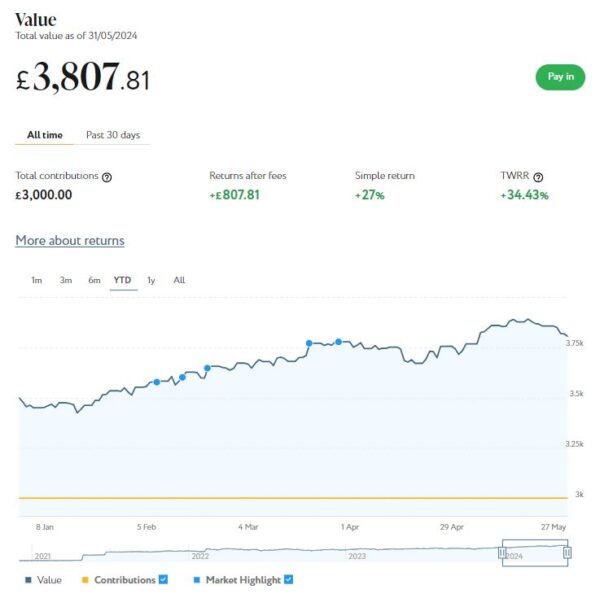
Finally, at the start of December 2023 I invested £500 in one of Nutmeg’s new thematic portfolios (Resource Transformation). In March I also invested a further £200 from ‘Refer a Friend’ bonuses. As you can see from the screen capture below, this portfolio is now worth £766 (rounded up) compared with £755 last month, a small rise of £11.
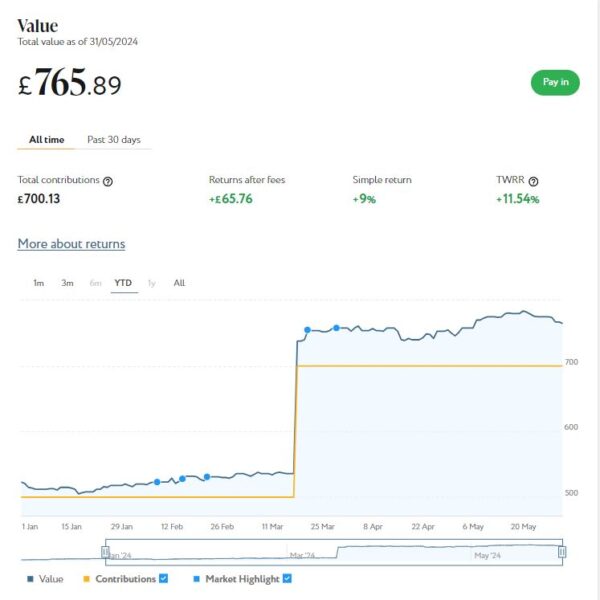
As you can see from the charts, May was an up-and-down month for my Nutmeg investments. In the the middle of the month all my portfolios were up substantiaily, but since then they have fallen back a bit. Overall, however, I am still up by £301 over the month, so it could be worse! It’s also worth observing that their overall value has risen by £1,693 or 6.85% since the start of the year (not counting the £200 bonus I invested in my thematic portfolio in March).
You can read my full Nutmeg review here. If you are looking for a home for your annual ISA allowance, based on my overall experience over the last eight years, they are certainly worth considering. They offer self-invested personal pensions (SIPPs), Lifetime ISAs and Junior ISAs as well.
- You may like to note that, for various reasons I won’t go into here, I am no longer an affiliate for Nutmeg. That means you won’t find any affiliate links in my review (or anywhere else on PAS). And you will no longer see the no-fees-for-six-months offer I used to be able to promote as an affiliate. However, the better news is that you can still get six months free of any management fees by registering with Nutmeg via my Refer a Friend link. I will receive a gift voucher if you do this, which is duly appreciated 🙂
Don’t forget, also, that the new tax year began on 6 April 2024 and and you now have a whole new £20,000 tax-free ISA allowance for 2024/25. In a change to the rules, you can now open any number of ISAs with different providers in the same tax year, as long as you don’t exceed your overall £20,000 allowance. So opening a stocks and shares ISA with Nutmeg won’t prevent you from also opening one with another S&S ISA provider (should you so wish) later in the financial year.
Moving on, I also have investments with the property crowdlending platform Kuflink. They continue to do well, with new projects launching every week. I withdrew £250 from my Kuflink account last month after a couple of loans were repaid. I currently have around £1,330 invested with them in 8 different projects paying interest rates averaging around 7%. I also have £20 remaining in my Kuflink cash account.
To date I have never lost any money with Kuflink, though some loan terms have been extended once or twice. On the plus side, when this happens additional interest is paid for the period in question.
There is now an initial minimum investment of £1,000 and a minimum investment per project of £500. Kuflink say they are doing this to streamline their operation and minimize costs. I can understand that, though it does mean that the option to test the water with a small first investment has been removed. It also makes it harder for small investors (like myself) to build a well-diversified portfolio on a limited budget.
One possible way around this is to invest using Kuflink’s Auto/IFISA facility. Your money here is automatically invested across a basket of loans over a period from one to five years. Interest rates range from 7% to around 10%, depending on the length of term you choose. Full up-to-date details can be found on the Kuflink website.
You can invest tax-free in a Kuflink Auto IFISA. Or if you have already used your annual ISA allowance elsewhere, you can invest via a taxable Auto account. You can read my full Kuflink review here if you wish.
Moving on, my Assetz Exchange investments continue to generate steady returns. Regular readers will know that this is a P2P property investment platform focusing on lower-risk properties (e.g. sheltered housing). I put an initial £100 into this in mid-February 2021 and another £400 in April. In June 2021 I added another £500, bringing my total investment up to £1,000.
Since I opened my account, my AE portfolio has generated a respectable £184.78 in revenue from rental income. As I said in last month’s update, capital growth has slowed, though, in line with UK property values generally.
At the time of writing, 11 of ‘my’ properties are showing gains, 1 is breaking even, and the remaining 18 are showing losses. My portfolio is currently showing a net decrease in value of £31.44, meaning that overall (rental income minus capital value decrease) I am up by £153.34. That’s still a decent return on my £1,000 and does illustrate the value of P2P property investments for diversifying your portfolio. And it doesn’t hurt that with Assetz Exchange most projects are socially beneficial as well.
The overall fall in capital value of my AE investments is obviously a little disappointing. But it’s important to remember that until/unless I choose to sell the investments in question, it is largely theoretical, based on the most recent price at which shares in the property concerned have changed hands. The rental income, on the other hand, is real money (which in my case I’ve reinvested in other AE projects to further diversify my portfolio).
To control risk with all my property crowdfunding investments nowadays, I invest relatively modest amounts in individual projects. This is a particular attraction of AE as far as i am concerned (especially after Kuflink raised their minimum investment per project to £500). You can actually invest from as little as 80p per property if you really want to proceed cautiously.
- As I noted in this recent post, Assetz Exchange is particularly good if you want to compound your returns by reinvesting rental income. This effectively boosts the interest rate you are receiving. Personally, once I have accrued a minimum of £10 in rental payments, I reinvest this money in either a new AE project or one I have already invested in (thus increasing my holding). Over time, even if I don’t invest any more capital, this will ensure my investment with AE grows at an accelerating rate and becomes more diversified as well.
My investment on Assetz Exchange is in the form of an IFISA so there won’t be any tax to pay on profits, dividends or capital gains. I’ve been impressed by my experiences with Assetz Exchange and the returns generated so far, and intend to continue investing with them. You can read my full review of Assetz Exchange here. You can also sign up for an account on Assetz Exchange directly via this link [affiliate]. Note that as from this financial year (2024/25), you can open more than one IFISA per year.
In 2022 I set up an account with investment and trading platform eToro, using their popular ‘copy trader’ facility. I chose to invest $500 (then about £412) copying an experienced eToro trader called Aukie2008 (real name Mike Moest).
In January 2023 I added to this with another $500 investment in one of their thematic portfolios, Oil Worldwide. I also invested a small amount I had left over in Tesla shares.
As you can see from the screen captures below, my original investment totalling $1,022.26 is today worth $1,301.38 an overall increase of $279.12 or 27.30%.


You can read my full review of eToro here. You may also like to check out my more in-depth look at eToro copy trading. I also discussed thematic investing with eToro using Smart Portfolios in this recent post. The latter also reveals why I took the somewhat contrarian step of choosing the oil industry for my first thematic investment with them.
- eToro also offer the free eToro Money app. This allows you to deposit money to your eToro account without paying any currency conversion fees, saving you up to £5 for every £1,000 you deposit. You can also use the app to withdraw funds from your eToro account instantly to your bank account. I tried this myself and was impressed with how quickly and seamlessly it worked. You can read my blog post about eToro Money here. Note that it can also serve as a cryptocurrency wallet, allowing you to send and receive crypto from any other wallet address in the world.
I had four more articles published in April on the excellent Mouthy Money website. The first is Earn Extra Money From Online Surveys. In this article I highlight how anyone can use this method to boost their bank balance for very little effort. I set out five well-established online survey sites I use myself to get you started.
Also in April Mouthy Money published my article How to Start a Business with a Franchise. In this I discussed the various attractions of starting a business with a franchise. And I shared some tips on choosing the best franchise for you and how to get the most out of it.
Also in Mouthy Money last month I revealed How to Track Down Old Investments and Bank Accounts using a platform called Gretel. Gretel is quick and easy to use, and free of charge for individuals (Gretel make their money from the banks and other financial institutions they work with). As well as using it for yourself, you can track down lost and missing assets for people you are associated with. Examples might include deceased persons where you are acting as executor, or people for whom you have financial power of attorney.
Finally, Mouthy Money published my article Should You Get Home Storage Batteries? In this I made the point that only a few years ago home storage batteries were very costly and hard for most people to justify. Times have changed, however, with the price of batteries falling while the cost of electricity has risen dramatically. So in this article I examined the case for purchasing a battery energy storage system (or BESS as it’s sometimes called). This applies principally if you have solar PV panels (or plan to get them) but may still be relevant to you even if you don’t.
As I’ve said before, Mouthy Money is a great resource for anyone interested in money-making and money-saving. I am a particular fan of my fellow MM contributor and money blogger Shoestring Jane. She writes mainly about money saving and frugal living. Her latest article sets out various ways you may be able to Save Money in the Sunshine. Let’s hope we actually get some soon! You can see all of Jane’s articles for Mouthy Money via this web page.
I also published several posts on Pounds and Sense in May. In My Short Break on the Isle of Man I talked about my recent holiday on this lovely and under-appreciated island between England and Ireland. It’s less than an hour by plane from most UK airports, or you can get a ferry from Liverpool or Heysham. I went on a heritage-railway-themed break with Newmarket Travel, which I thoroughly enjoyed and recommend. Read the article for more details
Also in May I published Twenty Great Ways to Make Extra Money From Home. This is a fully revised and updated version of my original post of this title. As you will gather, it sets out twenty ways you may be able to make a few pounds extra every month to help boost your finances. None of these methods is likely to make you a fortune, but together they can certainly help keep your bank balance ticking over.
Finally, with an eye to the General Election on Thursday 4th July 2024, I published How to Apply for a Postal Vote. As Pounds and Sense is aimed primarily at over-fifties, I wanted to encourage my readers to apply for a postal vote if this might help them exercise their democratic right to vote. Having a postal vote means that if ill health, frailty or disability prevent you getting to a polling station, you still have the chance to express your political preference. Likewise, you won’t have to worry about obstacles such as bad weather or lack of transport to get to the polling station. There is still time to apply for a postal vote if you wish but you need to move smartly now. This article will tell you everything you need to know.
Also this year I became a regular contributor to Over 60s Discounts. You can read my latest article here: Set Sail for the Sun! Ten Tips for Older Cruisers. As you will gather, this is intended for older people (especially) who are considering going on a cruise – maybe for the first time – to help them get the most from it.
I highly recommend registering at Over 60s Discounts, by the way – they list a growing range of discounts and bonuses for older people, including some that are unique to O60D.
Next, a few odds and ends. One is that I recently invested some money (just over £1,000) in a Scottish wind farm project via a platform called Ripple Energy. The way this works is that you pay a one-off fee towards building the wind farm, and in exchange receive lower-cost, ‘green’ electricity once the wind farm is up and running. This will continue for the life of the wind farm (an estimated 20 years).
If you’re interested in learning more, you can visit the Ripple website via my referral link. If you then decide to invest yourself, you will get a £25 bonus credited to your account when generation starts (and so will I). Note that you will need to invest a minimum of £1,000 to qualify for the £25 bonus, but you can invest from as little as £25 if you like.
Also, I recently invested a small amount (£500) via a property loan investment platform called Crowdstacker. I have followed Crowdstacker for some time but never got around to investing with them. They are somewhat similar to Kuflink, but their minimum investment per project is lower (just £100) which makes building a diversified portfolio easier. In addition, rates of return are higher, typically 12% to 16%. Obviously higher returns are generally associated with higher risks, and it’s important to bear this in mind when investing – though as all loans are secured against property, you do have some protection. All investments are available in the form of a tax-free IFISA within your overall £20,000 annual ISA allowance.
Crowdstacker doesn’t have a referral programme as far as I know, so I am just sharing this info out of interest. If anyone has any questions or comments about Crowdstacker, feel free to leave them below as usual.
In addition, you might remember that a few weeks ago I published a post about a service called Gubbed. This is a no-cost, no-risk opportunity to make at least £1,000 (tax-free). I just need to mention that for operational reasons Gubbed have temporarily stopped taking on new clients. This will not affect existing clients (including several PAS readers), who will still receive their guaranteed minimum £1,000 payouts in due course. But for the time being I have removed any advertising for Gubbed from Pounds and Sense. I will of course let readers know via Facebook and Twitter/X (see below) when they reopen to new clients.
UPDATE 5 June 2024 – Gubbed have now reopened to new applications. Here’s a link to my blog post about this opportunity again.
Finally, my usual reminder that you can also follow Pounds and Sense on Facebook or Twitter/X. Twitter/X is my number one social media platform these days and I post regularly there. I share the latest news and information on financial (and other) matters, and other things that interest, amuse or concern me. So if you aren’t following my PAS account, you are definitely missing out!
That’s all for today. As always, if you have any comments or queries, feel free to leave them below. I am always delighted to hear from PAS readers
Disclaimer: I am not a qualified financial adviser and nothing in this blog post should be construed as personal financial advice. Everyone should do their own ‘due diligence’ before investing and seek professional advice if in any doubt how best to proceed. All investing carries a risk of loss. Note also that posts on PAS may include affiliate links. If you click through and perform a qualifying transaction, I may receive a commission for introducing you. This will not affect the product or service you receive or the terms you are offered, but it does help support me in publishing PAS and paying my bills. Thank you!




